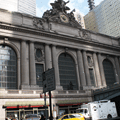
New York's Grand Central Terminal.
Soon after the new year began, the thought occurred to me that 2011 marks the 10th anniversary of the terrorist attacks on New York City and Washington, D.C.
On one hand, this came as no surprise to me. The older I get, the faster the years speed by.
On the other, I’m amazed that almost a decade has passed since Sept. 11, 2001. Perhaps the reason I feel this way is because the memories of that date and the days immediately after it are still so vivid.
Even now, people I meet can recall exactly where they were that day and what they were doing. Indeed, as the bumper stickers stated at the time, we will never forget.
So, while we may not need another reminder, the subject ofpme’scover story this month demonstrates how our world has changed in the last 10 years.
The Center for Medical Science in Albany, N.Y., today has a laboratory with a bio-safety level allowing scientists to research toxins and other contagious materials that could be used in future terrorist attacks. In this lab and other BSL-3 labs, researchers working in a gas-tight enclosed facility conduct ex-periments on airborne agents with potential to cause lethal infection.
What needs to be underscored is that this critical research would not be possible without the expertise of engineers who designed the lab’s plumbing and mechanical systems. Working with industry manufacturers and installing contractors, engineers designed systems that ensure deadly toxins do not harm the researchers or other tenants in the building through air or water.
Another case study in this month’spmedescribes construction work currently ongoing at Grand Central Terminal in midtown Manhattan. Yes, busy Grand Central Station-as it’s commonly known-will get even busier when workers complete the addition of eight more tracks and four more platforms on the 47-acre site. That project will conclude in 2016.
A smaller $21 million renovation project slated for completion this August features new quarters for conductors and engineers, and public tennis courts in the terminal’s annex. Our case study takes a look at how the latest 3-D BIM software aided the entire construction team in the design and coordination process and derailed potential MEP clashes with the annex renovation.
By the time the Grand Central project is finished, new buildings and a transportation hub will occupy the World Trade Center site in lower Manhattan. I can assure you the city’s new and expanded train stations will see just as many people arriving in New York as departing.
My first plane ride following the 2001 terrorist attacks was six weeks later into New York City. The fact I was there on a business trip showed how ready New Yorkers were to get back to work.
I didn’t visit Ground Zero on the trip, partly due to the security there and also my schedule. Still, I saw tributes to the city’s rescue workers and victims of the attacks everywhere I went.
Last March, I finally had the opportunity to visit the World Trade Center site in the company of plumbing contractors whose company is installing piping in one of the new buildings. While security remained extremely tight, the level of activity on the jobsite rivaled Grand Central Station.
As we commemorate in 2011 the tragic events of 10 years ago, let’s also remember the positive contributions our industry makes to building our country and keeping it prepared.
